Betelgeuse, the dying giant star
Betelgeuse, whose name derives from Arabic and means "hand of the giant", is the second brightest star in the constellation of Orion after Rigel, and, on average, the tenth brightest star in the night sky seen with the naked eye. It is one of the vertices of the Winter Triangle, together with Sirius and Procyon.
Betelgeuse begins to be seen low on the eastern horizon in late autumn evenings (early December), but it is during the months of January and February that the star dominates the night sky, being the brightest bright red star of winter. The month of May instead sees it set definitively below the western horizon, between the lights of the twilight; it returns to being visible to the east, just before dawn, in the month of August.
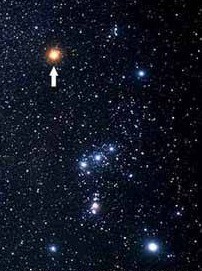
Most of the stars in the constellation Orion belong to a stellar association which includes almost all the blue stars visible in the constellation, especially those that make up the Belt and the Sword, which is found in close association with the vast complex of giant molecular clouds known as the Orion complex, formed very recently, starting from only 10 million years ago (on Earth it was the Miocene, the period of the great giant mammals, and the dinosaurs had now disappeared for a long time). After its formation, Betelgeuse underwent two gravitational accelerations that brought it to its current position: a first that would have moved it from the region of formation to about 200 parsecs and a second, which occurred about one million years ago, responsible for the current proper motion.
This second acceleration would have been caused by the explosion, in the region between the association and the nearby bubble of Eridanus, of one or more supernovae, whose shock waves would have modified the revolution motion of the celestial body around the galactic center in a linear motion.
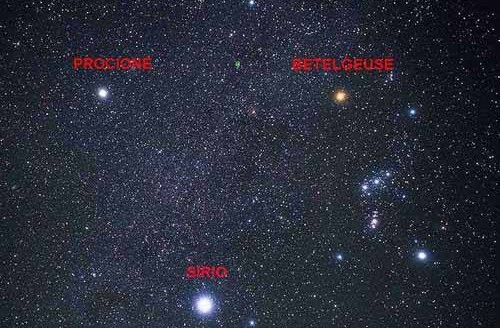
Betelgeuse and the other stars of the winter triangle are located within the Milky Way and precisely in the Orion constellation, a secondary galactic arm located between the Perseus Arm and the Sagittarius Arm within which our solar system is also located; the two arms are separated by about 6,500 light-years away.
Betelgeuse is a red supergiant, or rather a star in an already rather advanced stage of its evolution, which shows episodes of variability due to almost regular pulsations of the celestial body with a period between 2070 and 2355 days. Its distance from the Earth was estimated until a few years ago about 427 light years, but recent parallax measurements have suggested a higher value, equal to about 600-640 light years; in the light of this new value it was necessary to update most of the stellar parameters, in particular its radius. The angular diameter measured from the Earth suggests, from this distance, that Betelgeuse is a star of colossal dimensions, even one of the largest known: its radius would measure on average 4.6 AU (astronomical units), equal to about 1000 times the Sun beam. To get an idea of its size, if the star were in the place of the Sun, its surface would enter the main asteroid belt, eventually encompassing the orbit of Jupiter.
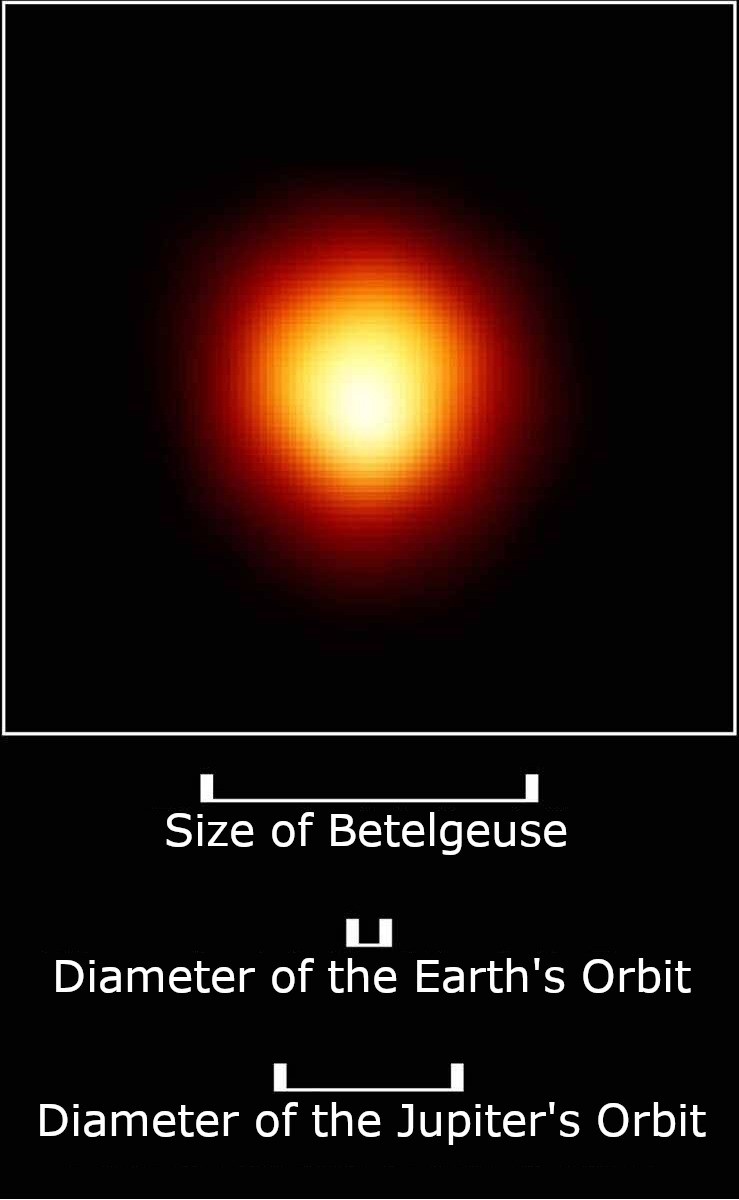
Given the large radiant surface, Betelgeuse also has a strong luminosity, which also makes it one of the brightest stars ever. However, such brightness is not exclusively attributable to the vast surface; for this reason astronomers tend to believe that the star has a high mass, equal to 15-20 times that of the Sun. Therefore it is possible that the star will end its existence by exploding in a supernova.
The large dimensions are also, in part, at the origin of the high luminosity of the star, which in the visible is about 9400 times the solar luminosity. However, if we take into account the emission at other wavelengths of the electromagnetic spectrum, particularly in the infrared, the star reaches a much higher luminosity, over 135,000 times that of the Sun. The reason for this large infrared emission it is due to the low surface temperature (about 3500 K) which means that the peak of the light emission is placed in the infrared; in fact, the celestial body emits only 13% of its radiant energy in the form of visible light.
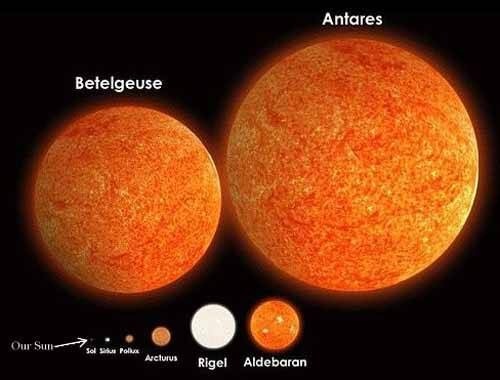
If the human eye were sensitive to all wavelengths of the electromagnetic spectrum, Betelgeuse would be the brightest star in the sky and would appear with an apparent magnitude close to that of the planet Venus.
Considering both dimensions and mass, the density of the star is extremely low: in fact, although the volume of the celestial body is over 160 million times the volume of the Sun, the mass-volume ratio gives an average density of 2-9 × 10-8 times that of our star, a density even lower than the best high vacuum possible on Earth. However, the very low density is a feature common to all red supergiants.
Betelgeuse is currently in the last stages of its evolution: the highly unstable red supergiant phase is in fact the prelude to the extinction of the star. Astronomers believe that Betelgeuse, due to its mass, during its main sequence phase was a class B star, with a typical blue-white color, and that it remained in this phase for at least 8-10 million years.
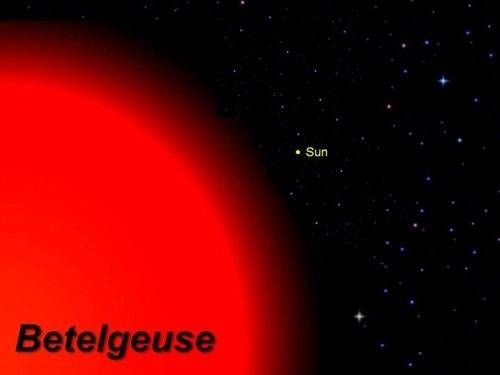
Once this phase of stability was concluded, in the last million years the star would have undergone a series of collapses which would have triggered subsequent nuclear reactions, eventually causing its expansion to its current state of red supergiant. Given its large mass, astronomers believe the star will end its life by exploding in a very bright type II supernova. It is not known exactly when this will happen; opinions are different. Some see the star's variability as an indication that it is already in the stage of fusing carbon into oxygen and neon, and therefore a few thousand years from its demise. Others reject this hypothesis, believing that it will still be a few million years before the explosion occurs; still others do not consider it improbable that the phenomenon may have already occurred, but exclude that it will be visible within a relatively short time (on a human scale), at most a few centuries.
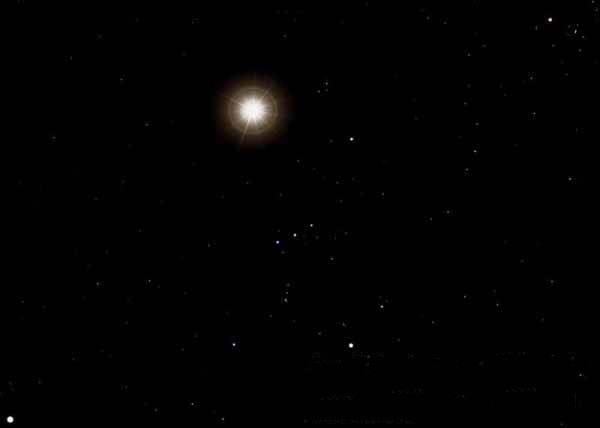
The star was kept alive thanks to the nuclear fusion reactions (nucleosynthesis) inside its core, which released the energy necessary to counteract the force of gravity which otherwise would have made the star collapse on itself. While the less massive stars (such as the Sun), in the phases following the main sequence, fuse the hydrogen in a layer superior to the helium nucleus and, only if the mass is sufficient, can they fuse the helium into carbon and oxygen. Once the fusion of helium into carbon is complete, massive stars reach the temperature and pressure conditions in their nuclei necessary for the fusion of the latter into heavier elements: oxygen, neon, silicon and sulphur.
The final products of nucleosynthesis are nickel and cobalt, the result of the silicon smelting process. These rapidly decay into iron, which is deposited inert in the center of the star. When the iron core reaches a mass greater than the Chandrasekhar limit, it becomes unstable, unable to emit further energy with fusion processes, but rather absorbs it, and therefore collapses into a neutron star; the formation of the neutron star causes the emission of a flux of neutrinos, which takes about an hour to pass through the outer hydrogen layer of the star and escape into the surrounding space. The collapse generates a series of shock waves which, after having taken about a day to reach the stellar surface, cause its dismemberment, giving rise to a sudden flash of ultraviolet radiation with an intensity equal to 100 billion times the solar luminosity. After the Big Bang, which however did not release photons as the Universe became transparent to electromagnetic radiation only after the inflationary era, the supernova explosion is believed to be the second most powerful explosion of the cosmos ever, capable of equaling and exceeding in brilliance the light of the entire Galaxy that hosts it. However, fortunately for us, despite its relative proximity, it is assumed that the radiation emitted by the Betelgeuse explosion will not cause major damage to our planet's biosphere.
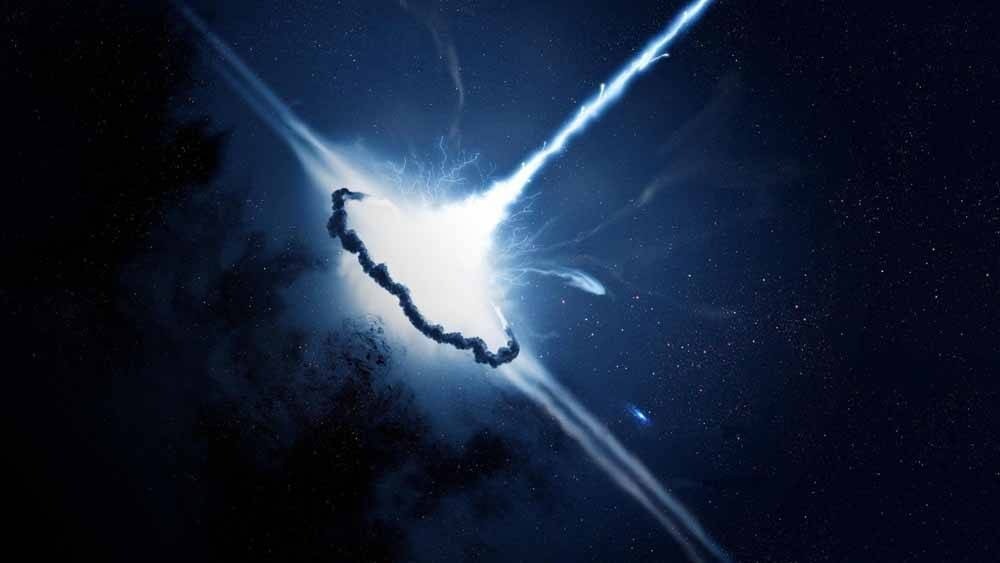
In the two weeks following the explosion (by now everything happens in a very short time), the total brightness of the supernova initially undergoes a decrease, to then reach its maximum brightness, while the expelled material expands, cooling, up to a distance equal to 100 AU from the star. At this point, the supernova remains in a stationary state for about 2-3 months, during which the absolute luminosity stands at a value equal to a billion times that of the Sun, while the effective temperature remains at 6000 K. From distance of 640 light years, Betelgeuse, or rather what remains of it, will be visible from the Earth with an apparent magnitude equal to that of a quarter of the Moon. In this phase Betelgeuse will also be visible during the day and these conditions will last for several months.
The immediately following years are marked by the radioactive decay of cobalt into iron. In the millennium following the explosion, the outer layers that made up the star expand until they reach an extension of 20 light years, becoming increasingly cold and rarefied and not very bright; thus the supernova remnant is formed, which will enrich the surrounding interstellar medium with the heavy elements produced by the star both during its last phases of life and during the explosion.
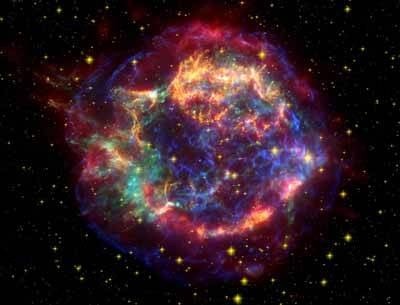
Rare elements such as gold, platinum, silver, uranium are generated precisely during the supernova phase, in a very short time of a few seconds. However, it is thanks to these reactions that the interstellar clouds (from which, due to the effect of compression waves and gravity, secondary stars subsequently originate generation like the Sun), are rich in many precious elements and molecules which, collected by the planets undergoing formation within stellar systems, can initiate those processes which, under particularly favorable circumstances, can initiate that set of electrochemical reactions that we we call life.
Therefore, the death and explosion of Betelgeuse, which will probably devastate and annihilate a large number of star systems with possible forms of life or even evolved civilizations with its radiations, sterilizing the universe for many light years, will also be the cause of the rebirth of new stars and new planets, increasingly rich in elements and complex molecules potentially capable of resurrecting life from its own ashes. Many human civilizations, which with their myths and religions have often celebrated cycles of rebirth, with the alternation of life and death as an essential peculiarity of the cosmos, without realizing it have really come very close to the truth, although in this universe with increasing entropy nothing lasts forever and everything, in many eons (a very distant period that we are not even able to understand, so far beyond the temporal scales to which we are accustomed), will cease forever, no more stars will be born from the death of the previous ones, and in that dilated instant, now timeless, will either really be the end, or cyclicity will involve this time the whole of existence, and from the thermal death of this extraordinary universe a new one will rise again, at that point really as part of an eternal cycle that someone already calls eternal inflation.


























